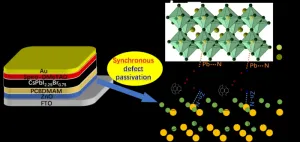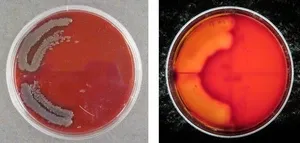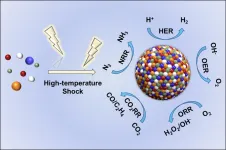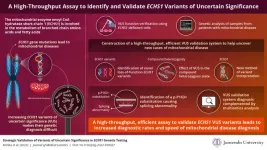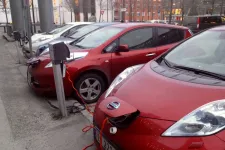(Press-News.org) Solar cells are a critical component to the transition to renewable energy sources, and enhanced power conversion efficiency (PCE), or amount of power captured with a given amount of sunlight, increases the practicality of solar power in a society with high energy demands. Perovskite solar cells that use all-inorganic perovskite light-absorbing materials are more thermally stable than organic-inorganic hybrid counterparts, but suffer from lower PCE. Researchers have overcome this hurdle in all-inorganic perovskite solar cells (PSC) by adding a conductive fullerene-derivative interlayer to enhance PCE and thermal stability.
All-inorganic perovskite solar cells have the advantage of increased thermal stability, which is critical for the longevity of solar cells, but lack in PCE compared to solar cells made with organic-inorganic hybrid counterparts. A group of leading material scientists recently investigated the use of an interlayer to ameliorate the defects found in all-inorganic PSCs. In PSCs, layers of perovskite, a material that conducts energy when exposed to light, are susceptible to problems in morphology, energy level mismatches and electron traps that decrease electron transport and overall solar cell efficiency. Introducing an interlayer of a fullerene derivative called bis-dimethylamino-functionalized fullerene derivative (PCBDMAM), sandwiched between the perovskite and the electron transport layer, remedies these deficiencies, increasing electron transport and PCE improving temperature stability.
The team published their findings in the May, 16 issue of Nano Research Energy, published by Tsinghua University Press.
“High-efficiency PSC devices are mostly based on organic-inorganic hybrid perovskite light-absorbing materials, which are intrinsically volatile and thermally unstable due to the existence of organic cations, resulting in poor thermal stability of PSC devices and hampering large-scale commercialization of organic-inorganic hybrid PSCs,” said Shangfeng Yang, lead principal investigator of the study and professor at the CAS Key Laboratory of Materials for Energy Conversion at the University of Science and Technology of China in Hefei, China. “To enhance the PCE of [all-inorganic perovskite] PSCs, interface engineering has been extensively applied and demonstrated to be effective in promoting electron transport by improving film morphology, lowering the energy level mismatch and passivating the antisite traps in perovskite,” said Yang.
“By using different types of interlayers including small molecules, polymers, inorganic compounds, 2D perovskite layers as well as fullerene and its derivatives, defect passivations of all-inorganic PSCs have been accomplished,” said Yang. In particular, the team used PCBDMAM as an interlayer between an all-inorganic perovskite layer and a zinc oxide electron transport layer. In this application, the PCBDMAM was spin-coated onto the zinc oxide surface as a conductive surface coating to mitigate the film morphology and other defects of the all-inorganic perovskite layer, improving the overall thermal stabilities of both the zinc oxide and perovskite layers and increasing PCE from 15.44% to 17.04%.
The successful transition to renewable energy sources depends, in part, on robust solar cells that can efficiently convert solar energy to electricity and withstand environmental extremes. Direct recombination, in particular, is a limiting factor in the efficiency of solar cells and presents a significant challenge for the research team and other material scientists. Direct recombination is the process by which electrons, created by light in the solar cell, and holes encounter one another and recombine. This recombination emits a photon, reversing electricity production in the solar cell.
The research team will continue to overcome hurdles to improve the functionality and lifespan of solar cells to make solar energy production more reliable and less expensive. Future challenges include further mitigating solar cell defects, including direct recombination, by altering the composition, concentration and application of solar cell layers to optimize temperature stability and efficiency in a commercially viable and cost-efficient way.
Other contributors include Yanbo Shang, Pu Wang, Lingbo Jia, Xingcheng Li, Weitao Lian, Peisan Qian, Tao Chen and Yalin Lu from the CAS Key Laboratory of Materials for Energy Conversion in the Anhui Laboratory of Advanced Photon Science and Technology from the Department of Materials Science and Engineering at the University of Science and Technology of China in Hefei, China; and Muqing Chen from the School of Environment and Civil Engineering at Dongguan University of Technology in Dongguan, China.
This work was supported by the National Natural Science Foundation of China (51925206, U1932214, 52172053).
##
About Nano Research Energy
Nano Research Energy is launched by Tsinghua University Press, aiming at being an international, open-access and interdisciplinary journal. We will publish research on cutting-edge advanced nanomaterials and nanotechnology for energy. It is dedicated to exploring various aspects of energy-related research that utilizes nanomaterials and nanotechnology, including but not limited to energy generation, conversion, storage, conservation, clean energy, etc. Nano Research Energy will publish four types of manuscripts, that is, Communications, Research Articles, Reviews, and Perspectives in an open-access form.
About SciOpen
SciOpen is a professional open access resource for discovery of scientific and technical content published by the Tsinghua University Press and its publishing partners, providing the scholarly publishing community with innovative technology and market-leading capabilities. SciOpen provides end-to-end services across manuscript submission, peer review, content hosting, analytics, and identity management and expert advice to ensure each journal’s development by offering a range of options across all functions as Journal Layout, Production Services, Editorial Services, Marketing and Promotions, Online Functionality, etc. By digitalizing the publishing process, SciOpen widens the reach, deepens the impact, and accelerates the exchange of ideas.
END
Children’s Cancer Research Fund has awarded $250,000 to an innovative new approach to treating leukemia – blood cancer – being developed at UVA Cancer Center.
The grant to John H. Bushweller, PhD, of the University of Virginia School of Medicine, is part of the national nonprofit’s efforts to accelerate the development of new and better treatments for difficult-to-treat cancers.
“This funding makes it possible to continue developing a novel approach to treatment for a form of pediatric leukemia with a very poor prognosis,” said Bushweller, of UVA’s Department of Molecular Physiology and Biological Physics. “For ...
INDIANAPOLIS – Every 40 seconds, someone in the U.S. has a stroke. Every 3.5 minutes, someone in the U.S. dies of a stroke. Stroke patients have multifaceted needs, requiring complicated care delivered by multidisciplinary teams.
In the journal Stroke’s annual review of quality improvement advances in stroke care studies, Regenstrief Institute Research Scientist Dawn Bravata, M.D., and colleagues update researchers, clinicians and healthcare administrators on advances in the field, highlighting the challenges of scalability and sustainability.
“Quality improvement exists to ensure that every patient with stroke or at risk of stroke is getting the care ...
High-temperature shock (HTS) is an emerging synthesis method with kinetics-dominated non-equilibrium characteristics, which can achieve an ultrafast heating/cooling rate of ~10^5 K/s and a peak temperature larger than ~3000 K within a time scale of seconds or milliseconds, and is widely used in the preparation of high entropy content, thermodynamic metastable phase and defect-rich materials. Amongst these significant advances, nanoscale high entropy alloys (HEA) are particularly prominent in heterogeneous catalytic reactions with remarkable ...
DANVERS, Mass., May 18, 2023 – Abiomed, part of Johnson & Johnson MedTech[1], announces results of a third-party analysis showing that utilizing Impella during high-risk percutaneous coronary intervention (PCI) procedures may help physicians achieve a more complete revascularization compared to high-risk PCIs supported using an intra-aortic balloon pump (IABP). Previous studies have shown that a more complete revascularization can lead to longer survival[2],[3], a greater reduction in heart failure and angina symptoms[4], and an improved quality of life for the patient[5].
This analysis shows ...
The gene ECHS1 encodes for enoyl-CoA hydratase short-chain 1, a mitochondrial enzyme involved in branched-chain amino acid and fatty acid metabolism. Rare inherited mutations in the ECHS1 lead to mitochondrial ECHS1 deficiency, resulting in the disruption of the metabolism of the essential amino acid valine and accumulation of valine intermediates.
In fact, ECHS1 is one of the most common causative genes of mitochondrial diseases. These mutant enzymes also cause brain lesions and severe delays in a child’s psychomotor development, along with elevating blood lactate levels. ECHS1 variants have been reported globally, and many disease-causing ...
Every second, the planet loses a stretch of forest equivalent to a football field due to
logging, fires, insect infestation, disease, wind, drought, and other factors. In a recently published study, researchers from the U.S. Geological Survey Earth Resources Observation and Science (EROS) Center presented a comprehensive strategy to detect when and where forest disturbance happens at a large scale and provide a deeper understanding of forest change.
The study was published on Feb. 28 in the Journal of Remote Sensing.
“Our strategy leads to more accurate land cover ...
Most global scenarios and governmental targets for decarbonizing the transport sector consider battery-powered electric vehicles as a main part of the solution. Enormous amounts of raw materials are needed to build enough batteries and ensure a transition to low-emission vehicles.
Access to lithium is critical, as it is used in all types of EV batteries.
Future demand needs to decrease
“It seems very likely we'll have a shortage. The key lies in the demand. The demand needs to decrease to avoid long-term supply problems,” ...
Satellites launched into outer space could send back improved warnings of dangerous solar storms thanks to a breakthrough in the way scientists use space weather measurements.
Experts from the University of Reading have found that using satellite data that is less reliable but is returned to Earth rapidly can be used to improve the accuracy of solar wind forecasts - which are harmful streams of charged particles sent from the sun - by nearly 50 per cent.
Their research, published today (Thursday, 18 May) in Space Weather, ...
A new study uncovers how the interplay between Sargassum spp., plastic marine debris and Vibrio bacteria creates the perfect “pathogen” storm that has implications for both marine life and public health. Vibrio bacteria are found in waters around the world and are the dominant cause of death in humans from the marine environment. For example, Vibrio vulnificus, sometimes referred to as flesh-eating bacteria, can cause life-threatening foodborne illnesses from seafood consumption as well as disease and death from open wound infections.
Since 2011, ...
A new study by Dr. Lucie Kvasničková Stanislavská from Czech University of Life Sciences, Prague published in PeerJ Computer Science titled ‘Global analysis of Twitter communication in corporate social responsibility area: sustainability, climate change, and waste management’ has found that social media is an increasingly important tool for companies to communicate their corporate social responsibility (CSR) efforts. The study analyzed over half a million tweets from 2017 to 2022 and identified the key topics and trends communicated in connection with CSR on Twitter.
“Our results aid enterprises in developing communication ...
